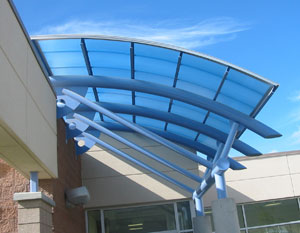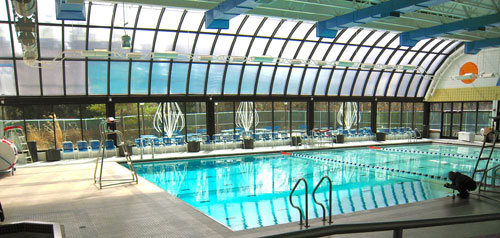Translucent Cellular Polycarbonate Delivers Design Versatility
Thermally Dynamic Material
Polycarbonate expands and contracts thermally more than most materials (about seven times as much as glass or steel and about three times as much as aluminum). It even moves with the temperature differential that occurs from day to night. Thermally induced expansion and contraction of PCSS can amount to 1/8-in. per 3 ft per 100-degree temperature change. Some manufacturers compensate for this by designing retention clips and framing that allows for sheet movement (see Framing below.)
Engineered framing and clip designs can also eliminate sounds caused by the expansion or contraction of PCSS panels.
LED Lighting
 |
MHTN Architects, Salt Lake City, Utah, designed a series of cold-curved blue cellular polycarbonate canopies for the Rose Springs Elementary School in Tooela, Utah. Photo by Dave Bardsley |
PCSS lends itself to interior applications where background lighting is desired. The cellular, fluted structure diffuses the light and, in some applications, causes the light to “run up” the flutes. It is even possible to incorporate “rope” LED lighting into the flutes themselves.
Lightweight
A 1-in.-thick piece of cellular polycarbonate weighs approximately 0.65 lb/sq ft compared to 6.25 lb/sq ft for 1 in. of insulated glass. This difference is so dramatic that buildings that incorporate PCSS skylights or canopies can be built with lighter, less expensive framing systems. Light weight also offers significant savings in transportation, handling and installation.
Cold Bending
PCSS can be cold bent (curved) lengthwise, usually over a series of supports which are spaced so as to determine the curvature. Once a sheet is removed from its form, it will regain its flat profile. Cold bent polycarbonate is a solution for applications such as canopies and barrel vault skylights. It should be noted that curving also adds significant spanning strength to the panels. Specifiers should be aware that over-bending may constitute a breach of warranty.
 |
Example of a barrel vault skylights with curved cold bent PCSS panels held by aluminum battens. Photo by Cameron Duncan, AIA |
Table of Bending Radii |
||||||||||||||
|
||||||||||||||
Acoustical and Sound Transmission Limitations
PCSS tends to reflect sound more than alternate materials that have softer and more textured surfaces. It must be used carefully for interiors. Manufacturer's product data sheets note the decibel level (dB) or level of transmission of sound for different thicknesses. A three-wall, 25mm PCSS sheet, for instance, has a 22-dB value (a bird call is 40 dB).
Easy to Clean
PCSS products are easily cleaned using detergent and water or power washing. However, one of the virtues of PCSS is that, owing to the light-diffusing nature of the multi-cells, it doesn't show the dirt. This same quality hides scratching or other imperfections. While glass glazing requires periodic cleaning, PCSS glazing is seldom cleaned—thus providing considerable maintenance savings.
Anti-Condensation
Water droplets on the inside surface of polycarbonate glazing (or any other glazing material) will reduce light transmission and, if the droplets fall, they can damage greenhouse plants, sensitive goods and equipment below. Anti-condensation PCSS sheets are available to which a surfactant coating has been applied. Surfactants are chemicals which cause water to spread out across a surface. This helps prevent the dripping of water droplets, while allowing a thin layer of water to run off the polycarbonate sheet without affecting light transmission. This is a technology which is used mostly in greenhouses.









